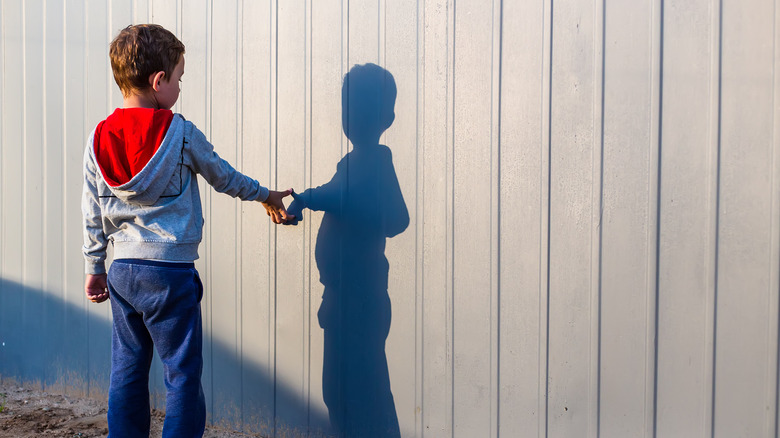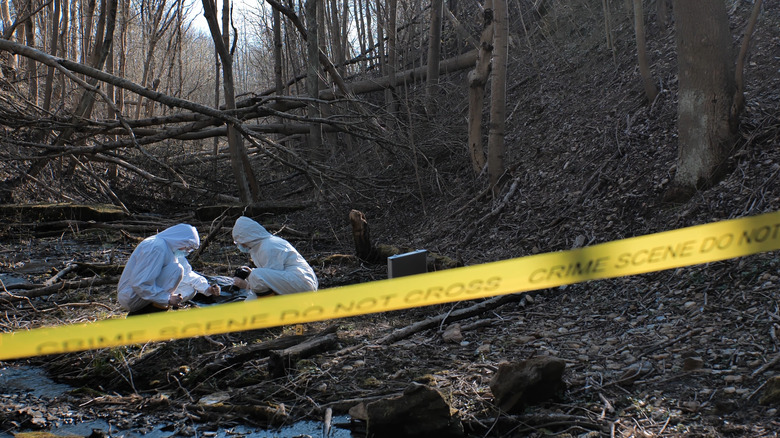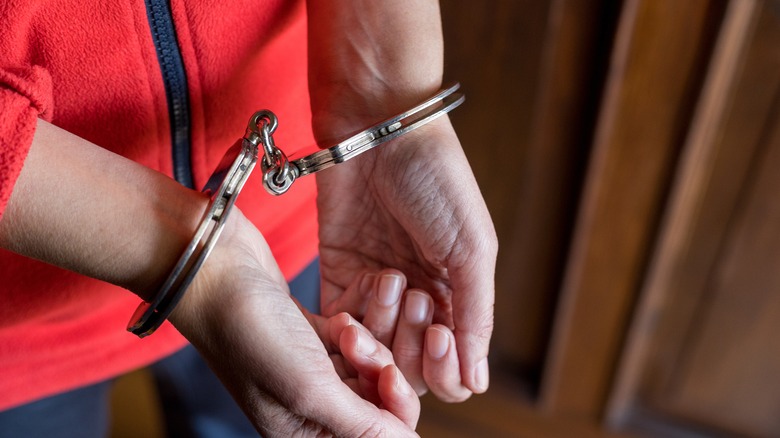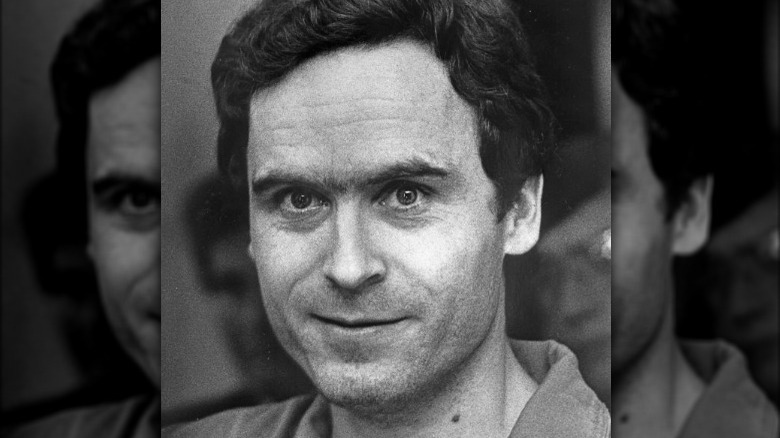The Truly Horrific Crime Scene Of Ted Bundy's FSU Sorority House Attack
John Wayne Gacy. Ed Gein. Richard Ramirez. On the list of the most infamous American serial killers all time, Ted Bundy comes in somewhere near the top. Bundy, who committed at least 28 murders, went on his killing spree in the mid- to late-1970s, according to Britannica. Arrested by police multiple times due to his suspicious behavior, Bundy also escaped multiple times, according to the Crime Museum. Bundy was eventually sentenced to death in 1979 and was executed in 1989, according to All That's Interesting.
During his crime spree and trial, Bundy drew plenty of public attention, according to Britannica. Now, more than three decades after Bundy died, he remains a well-known figure in popular culture, and his story has spawned almost a dozen different documentaries and other shows, including Netflix's "Extremely Wicked, Shockingly Evil, and Vile," and older films like 2003's "The Stranger Beside Me," according to Fansided. But though many people are familiar with the basics of Bundy's crimes, not everyone is as dialed-in to the gruesome specifics. And with Bundy, there are plenty of gruesome specifics, including the details of the 1978 crime scene at the Florida State University Chi Omega Sorority House in Tallahassee, Florida (via Narcity), for which Bundy was eventually sentenced to death.
Ted Bundy's childhood
Like many serial killers, Bundy had an abnormal childhood. Bundy's mother was very young when she had her son. When he was a toddler, he was told she was his sister, not his mother (via Biography). Later in life, Bundy would sometimes say that he thought his life as a kid was pretty average, according to The Washington Post, but at other times he remembered a lonelier childhood, according to the Crime Museum. He stole often, and also often spied on women. People who knew Bundy as a child later recalled that he had a speech impediment and was cut from the school sports teams.
Bundy's relationships with the father figures in his life were also tense. Some people have speculated that Bundy was abused by his grandfather, his mother's father, according to Biography. Later, Bundy and his mother moved and she remarried, but Bundy wasn't necessarily fond of his new stepfather either. He and his stepfather fought and his stepfather occasionally hit him.
How Bundy became a killer
Ted Bundy committed his first violent crime in 1974 when he was a law student, according to All That's Interesting. Bundy had graduated college two years prior, according to the Crime Museum, and had started at the University of Puget Sound Law School in Seattle in 1973. On January 4, 1974, Bundy invaded the home of a girl named Karen Sparks, where he beat her until she had permanent brain damage, according to Biography. She survived, but after that, Bundy began killing his victims.
As Bundy's list of victims grew, he began to develop his own unique method of luring women in. First, Bundy would pretend to be injured or disabled and ask women for help lifting things, according to the Crime Museum. The girls would let down their guard, and when they weren't paying attention he would bludgeon them, then rape them and mutilate them. Remarkably, police were tipped off to Ted Bundy's involvement rather early in the course of Bundy's killing spree, with four different people identifying Ted Bundy as a potential suspect in 1974, according to All That's Interesting. But police didn't think Bundy was a good suspect, and eventually, Bundy left the Washington area, continuing his murder spree in Utah and Colorado, according to Biography.
Bundy's first arrest and escape
In the five years between Bundy's first killing in 1974 and when he was sentenced for murder in 1979, he was actually captured by police on separate charges, according to Biography. In 1975, Bundy was caught and charged with attempted kidnapping, and was later sentenced to as many as 15 years in jail. However, Bundy escaped police custody by jumping out of a courthouse window. Later, he was recaptured and sent to a Colorado jail, but ultimately he escaped from there, too.
After Bundy's escape, authorities remained on the lookout for the prisoner. However, despite his newfound tabloid notoriety (via Britannica) Bundy opted not to go low profile and take a break from killing. Instead, after his December 30, 1977 escape, he made his way to northern Florida, according to ABC News, and less than a month after he made it out of prison, he found his next set of victims in a sorority house at Florida State University.
The FSU crime scene
Before dawn on January 15, 1978, police received a call about an incident at a local sorority house, the Chi Omega House, on the Florida State University Campus (via ABC News). Officers responding to the call found a scene of panic and carnage. Four members had been attacked around 3 a.m. Two of them had severe injuries from a beating, including a girl named Kathy Kleiner, whose jaw had been broken in three places, and her roommate, Karen Chandler, who had significant head injuries. Kleiner recalled waking up when her attacker came into the room, but not being able to see him or defend herself, according to Meaww. But worse was the scene around Margaret Bowman and Lisa Levy. These sorority sisters, who were beaten, strangled, and sexually assaulted, didn't survive the attack, according to CBS News.
Still, these four attacks weren't enough for Bundy, and that same night, Bundy assaulted Cheryl Thomas, another FSU student, in her nearby home. She was also beaten by Bundy, but attributes her survival to the quick thinking of her neighbors, who heard the commotion in her apartment and called the police, according to ABC News. Initially, authorities didn't believe Bundy could be responsible for the attacks, because he had never gone on a killing spree within girls' homes before. However, when Bundy was arrested in a nearby area for having stolen license plates, authorities connected the dots and charged him with murder (via ABC News).
Aftermath of the attack
Bundy was placed on trial in June of 1979 for the murders he committed at the Chi Omega house, according to Biography. The trial, which lasted almost a month, culminated in a guilty verdict. Bundy was sentenced to death by electrocution. Later, Bundy would go on to be tried for other crimes, but it was ultimately the death sentence delivered to him in the FSU sorority house case which sealed his fate.
The survivors of the sorority house murders healed in the weeks and months following the attack, though the impact of their injuries and mental distress lasted for many more years, according to ABC News. Kathy Kliener shared that she struggled to come to terms with the deaths of her sorority sisters. And Cheryl Thomas, who was assaulted near the sorority house, deals with permanent deafness as a result of the attack (via CBS News).





